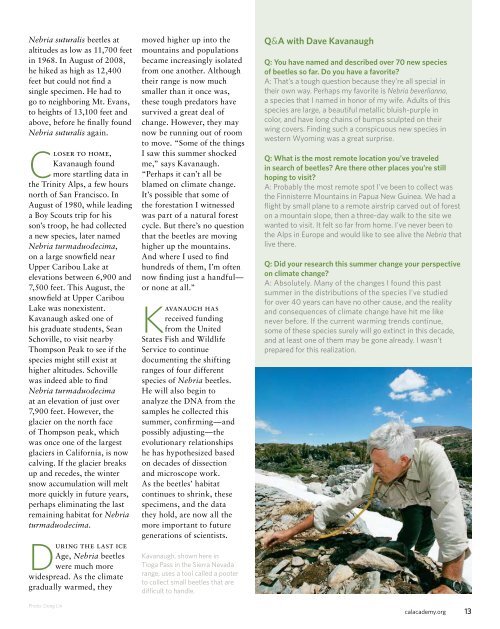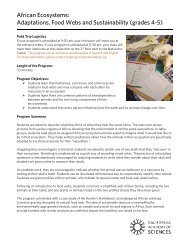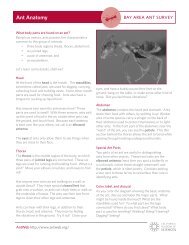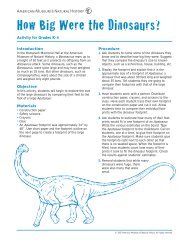Squawk of the town: Academy receives Platinum rating - California ...
Squawk of the town: Academy receives Platinum rating - California ...
Squawk of the town: Academy receives Platinum rating - California ...
You also want an ePaper? Increase the reach of your titles
YUMPU automatically turns print PDFs into web optimized ePapers that Google loves.
Nebria suturalis beetles at<br />
altitudes as low as 11,700 feet<br />
in 1968. In August <strong>of</strong> 2008,<br />
he hiked as high as 12,400<br />
feet but could not find a<br />
single specimen. He had to<br />
go to neighboring Mt. Evans,<br />
to heights <strong>of</strong> 13,100 feet and<br />
above, before he finally found<br />
Nebria suturalis again.<br />
Closer to home,<br />
Kavanaugh found<br />
more startling data in<br />
<strong>the</strong> Trinity Alps, a few hours<br />
north <strong>of</strong> San Francisco. In<br />
August <strong>of</strong> 1980, while leading<br />
a Boy Scouts trip for his<br />
son’s troop, he had collected<br />
a new species, later named<br />
Nebria turmaduodecima,<br />
on a large snowfield near<br />
Upper Caribou Lake at<br />
elevations between 6,900 and<br />
7,500 feet. This August, <strong>the</strong><br />
snowfield at Upper Caribou<br />
Lake was nonexistent.<br />
Kavanaugh asked one <strong>of</strong><br />
his graduate students, Sean<br />
Schoville, to visit nearby<br />
Thompson Peak to see if <strong>the</strong><br />
species might still exist at<br />
higher altitudes. Schoville<br />
was indeed able to find<br />
Nebria turmaduodecima<br />
at an elevation <strong>of</strong> just over<br />
7,900 feet. However, <strong>the</strong><br />
glacier on <strong>the</strong> north face<br />
<strong>of</strong> Thompson peak, which<br />
was once one <strong>of</strong> <strong>the</strong> largest<br />
glaciers in <strong>California</strong>, is now<br />
calving. If <strong>the</strong> glacier breaks<br />
up and recedes, <strong>the</strong> winter<br />
snow accumulation will melt<br />
more quickly in future years,<br />
perhaps eliminating <strong>the</strong> last<br />
remaining habitat for Nebria<br />
turmaduodecima.<br />
During <strong>the</strong> last ice<br />
Age, Nebria beetles<br />
were much more<br />
widespread. As <strong>the</strong> climate<br />
gradually warmed, <strong>the</strong>y<br />
Photo: Dong Lin<br />
moved higher up into <strong>the</strong><br />
mountains and populations<br />
became increasingly isolated<br />
from one ano<strong>the</strong>r. Although<br />
<strong>the</strong>ir range is now much<br />
smaller than it once was,<br />
<strong>the</strong>se tough predators have<br />
survived a great deal <strong>of</strong><br />
change. However, <strong>the</strong>y may<br />
now be running out <strong>of</strong> room<br />
to move. “Some <strong>of</strong> <strong>the</strong> things<br />
I saw this summer shocked<br />
me,” says Kavanaugh.<br />
“Perhaps it can’t all be<br />
blamed on climate change.<br />
It’s possible that some <strong>of</strong><br />
<strong>the</strong> forestation I witnessed<br />
was part <strong>of</strong> a natural forest<br />
cycle. But <strong>the</strong>re’s no question<br />
that <strong>the</strong> beetles are moving<br />
higher up <strong>the</strong> mountains.<br />
And where I used to find<br />
hundreds <strong>of</strong> <strong>the</strong>m, I’m <strong>of</strong>ten<br />
now finding just a handful—<br />
or none at all.”<br />
Kavanaugh has<br />
received funding<br />
from <strong>the</strong> United<br />
States Fish and Wildlife<br />
Service to continue<br />
documenting <strong>the</strong> shifting<br />
ranges <strong>of</strong> four different<br />
species <strong>of</strong> Nebria beetles.<br />
He will also begin to<br />
analyze <strong>the</strong> DNA from <strong>the</strong><br />
samples he collected this<br />
summer, confirming—and<br />
possibly adjusting—<strong>the</strong><br />
evolutionary relationships<br />
he has hypo<strong>the</strong>sized based<br />
on decades <strong>of</strong> dissection<br />
and microscope work.<br />
As <strong>the</strong> beetles’ habitat<br />
continues to shrink, <strong>the</strong>se<br />
specimens, and <strong>the</strong> data<br />
<strong>the</strong>y hold, are now all <strong>the</strong><br />
more important to future<br />
generations <strong>of</strong> scientists.<br />
Kavanaugh, shown here in<br />
Tioga Pass in <strong>the</strong> Sierra Nevada<br />
range, uses a tool called a pooter<br />
to collect small beetles that are<br />
difficult to handle.<br />
Q&A with Dave Kavanaugh<br />
Q: You have named and described over 70 new species<br />
<strong>of</strong> beetles so far. Do you have a favorite?<br />
A: That’s a tough question because <strong>the</strong>y’re all special in<br />
<strong>the</strong>ir own way. Perhaps my favorite is Nebria beverlianna,<br />
a species that I named in honor <strong>of</strong> my wife. Adults <strong>of</strong> this<br />
species are large, a beautiful metallic bluish-purple in<br />
color, and have long chains <strong>of</strong> bumps sculpted on <strong>the</strong>ir<br />
wing covers. Finding such a conspicuous new species in<br />
western Wyoming was a great surprise.<br />
Q: What is <strong>the</strong> most remote location you’ve traveled<br />
in search <strong>of</strong> beetles? Are <strong>the</strong>re o<strong>the</strong>r places you’re still<br />
hoping to visit?<br />
A: Probably <strong>the</strong> most remote spot I’ve been to collect was<br />
<strong>the</strong> Finnisterre Mountains in Papua New Guinea. We had a<br />
flight by small plane to a remote airstrip carved out <strong>of</strong> forest<br />
on a mountain slope, <strong>the</strong>n a three-day walk to <strong>the</strong> site we<br />
wanted to visit. It felt so far from home. I’ve never been to<br />
<strong>the</strong> Alps in Europe and would like to see alive <strong>the</strong> Nebria that<br />
live <strong>the</strong>re.<br />
Q: Did your research this summer change your perspective<br />
on climate change?<br />
A: Absolutely. Many <strong>of</strong> <strong>the</strong> changes I found this past<br />
summer in <strong>the</strong> distributions <strong>of</strong> <strong>the</strong> species I’ve studied<br />
for over 40 years can have no o<strong>the</strong>r cause, and <strong>the</strong> reality<br />
and consequences <strong>of</strong> climate change have hit me like<br />
never before. If <strong>the</strong> current warming trends continue,<br />
some <strong>of</strong> <strong>the</strong>se species surely will go extinct in this decade,<br />
and at least one <strong>of</strong> <strong>the</strong>m may be gone already. I wasn’t<br />
prepared for this realization.<br />
calacademy.org 13



![download [PDF - 2.7mb] - California Academy of Sciences](https://img.yumpu.com/26596748/1/190x122/download-pdf-27mb-california-academy-of-sciences.jpg?quality=85)








![Download a visitor map [418k] - California Academy of Sciences](https://img.yumpu.com/26596645/1/190x88/download-a-visitor-map-418k-california-academy-of-sciences.jpg?quality=85)



